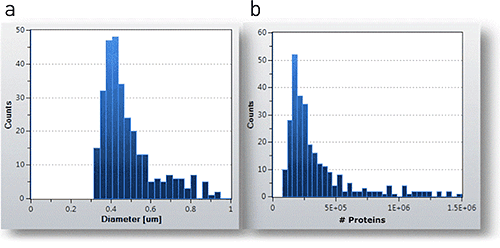The development of protein-based therapeutics is a rapidly-growing area of the pharmaceutical industry. Biopharmaceuticals are increasingly used to treat and prevent many diseases in humans and animals, and also to replace critical proteins that cannot be produced endogenously. In the formulations used to deliver these treatments, however, aggregation of therapeutic proteins can reduce their effectiveness and potentially induce immunogenic effects which may compromise drug safety and efficacy. It is therefore essential to monitor aggregation in the development, manufacture and storage of therapeutic proteins and other biopharmaceutical formulations.
To date, most accepted monitoring methods have included manual microscopy, light scattering detection, light obscuration, chromatography, and microfluidics coupled with automated imaging. These methods are suitable for many aggregation studies, but can be challenged by protein aggregates with widely variable transparency and shape, or those present in high concentrations. In addition, subvisible- and even submicron-scale aggregates are of growing R&D and quality control interest, but are often inaccessible to optical methods due to their limited resolution. Finally, protein formulations are often complicated by the presence of leachables such as silicone oil droplets and other foreign particulate matter introduced during product manufacture, handling and storage. An ideal analysis method for biopharmaceutical formulations would clearly distinguish contaminating matter from the aggregate content and analyze it independently.
Archimedes
is an innovative new benchtop instrument which detects and counts individual protein aggregates and other particles within a formulation and measures their mass and size by means of resonant mass measurement. This novel approach gives accurate and reproducible measurements of particle mass, concentration, and size, from a few microns down to approximately 50nm. This capability opens a new window on the analysis of protein formulations, below the range accessible by optical methods. Archimedes is unaffected by optical and shape variations, which can hinder alternative methods. Its gentle fluidics accommodate native concentrations up to 10^9 particles/ml and viscosities up to 100cP without dilution, and do not disturb fragile aggregates. The compact sensor fluidics require drawn samples as small as 100µL. And the concentration is measured directly since each aggregate is counted, one by one.

|
Archimedes' measurement principle is shown in Figure 1. Aggregates or other particles are flowed in suspension through a MEMS (Micro Electro-Mechanical Systems)-fabricated microfluidic channel which resonates mechanically at a known frequency. The mass added by the presence of an aggregate shifts the sensor's resonant frequency. These shifts are measured for each aggregate as it passes through the sensor, and the aggregate mass is determined with a resolution of 1 femtogram (10-15g). From these mass measurements, statistical views of the aggregate mass and size are produced. The corresponding size distributions are derived by translating the mass of each aggregate to its equivalent-sphere diameter.

|

|
Figure 2(a) shows the size distribution of submicron IgG protein aggregates in 4µL of formulation buffer. The measured concentration is 4x10^6 aggregates/mL for sizes >300nm. Because the underlying measurements are of mass, the distribution can be displayed as the number of protein molecules (of known mass) that make up each aggregate, as is shown in Figure 2(b) .
Archimedes has been used to analyze therapeutic protein formulations from a number of major biotechnology companies. Figure 2 (c) shows Archimedes' measurements of a range of samples, illustrating the concentration of aggregates in the size range 300nm - 1µm. A 10-fold increase in aggregates of this size through the sample series is evident, roughly corresponding to an aggregation cascade. Submicron aggregate concentration also correlates with formulation quality.
In addition, Archimedes can clearly distinguish contaminating material from protein aggregates. In Figure 3 for example, aggregates of densities greater than that of the suspension buffer create negative peaks. Also visible are positive peaks: these are caused by silicone oil droplets, whose density is less than that of the buffer so that their presence actually reduces the overall mass of the sensor and increases the sensor's resonant frequency. This difference in sign allows Archimedesto distinguish between aggregates and oil droplets, and distributions can be produced for each population, as shown in Figure 3.

|
Studies with Archimedeshave documented significant leachable content in biopharmaceutical formulations from packaging during handling and storage. Figure 4 shows the increase in total sub-400nm diameter oil droplet content in parts per billion, against packaging material type and age.

|
In another study, illustrated in Figure 5, a biotherapeutic formulation stored in plastic packaging was agitated over time and the contents sampled periodically. A significant growth in oil droplet content vs. agitation time was detected. Correlation between the presence of such leachables and the formation of aggregates can also be evaluated.
Archimedes opens a new window into the subvisible and submicron content of protein formulations. It can provide invaluable quantitative information on formulation quality and stability, and thus potentially on a preparation's safety and efficacy, early in the development and manufacturing process.

|